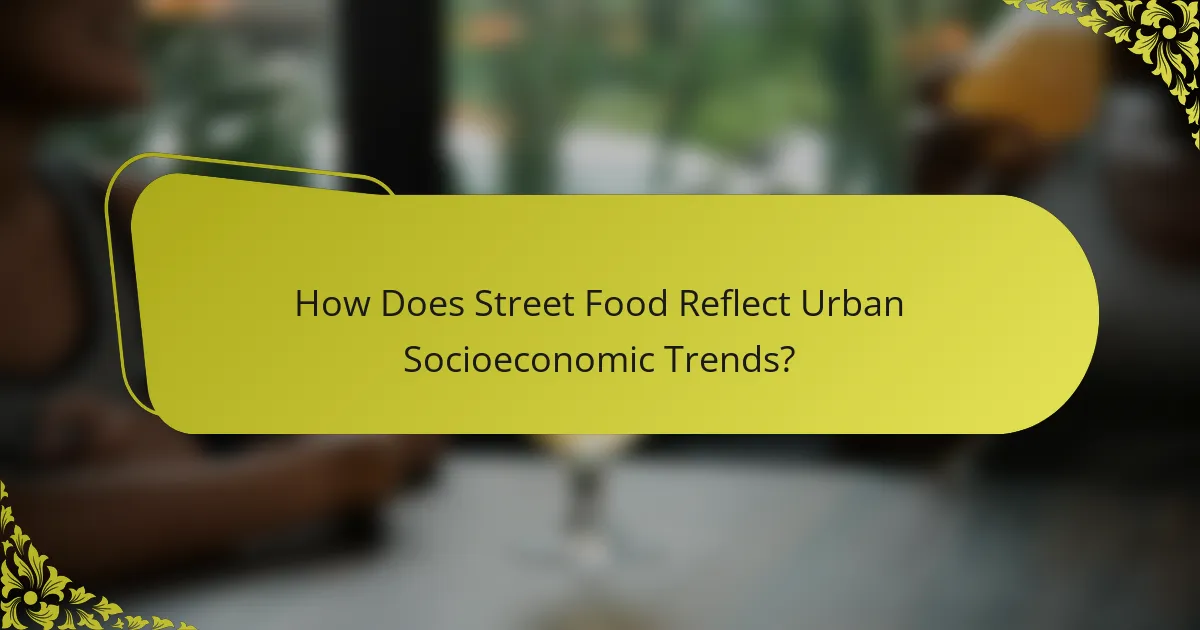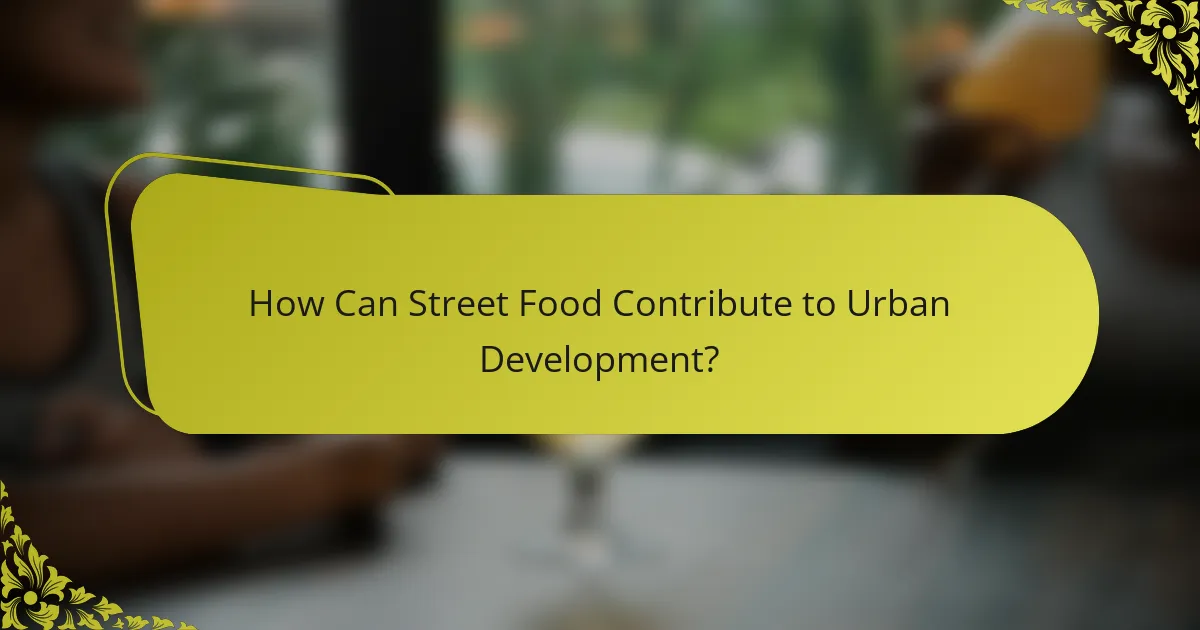Street food is a dynamic reflection of urban socioeconomic trends, revealing the diverse accessibility of culinary options across different income levels and cultural backgrounds. It plays a crucial role in preserving culinary traditions, fostering cultural exchange, and enhancing local identity, while also contributing to urban development by revitalizing public spaces and supporting local entrepreneurs.

How Does Street Food Reflect Urban Socioeconomic Trends?
Street food serves as a mirror to urban socioeconomic trends, showcasing the accessibility of food options for various income levels and cultural backgrounds. It highlights how economic conditions, employment opportunities, and social dynamics intertwine within city environments.
Economic accessibility for diverse populations
Street food is often more affordable than dining in restaurants, making it accessible to a wide range of income groups. Vendors typically offer meals at lower prices, allowing individuals from various socioeconomic backgrounds to enjoy diverse culinary options.
This economic accessibility fosters inclusivity, as street food markets often feature a variety of cuisines that reflect the cultural diversity of the urban population. For example, a city may have food stalls representing different ethnic communities, providing both affordable meals and cultural experiences.
Job creation in urban areas
Street food vendors contribute significantly to job creation in urban settings. They not only provide employment for the vendors themselves but also create additional jobs in related sectors, such as food supply, transportation, and marketing.
In many cities, the street food industry can employ hundreds to thousands of individuals, ranging from cooks to logistics personnel. This job creation helps reduce unemployment rates and stimulates local economies, particularly in areas with limited formal employment opportunities.
Influence on local economies
Street food has a notable impact on local economies by generating revenue and attracting tourism. Food markets and festivals can draw visitors, boosting sales for vendors and nearby businesses.
Moreover, street food often operates with lower overhead costs compared to traditional restaurants. This allows vendors to reinvest profits into their businesses or the local community, further enhancing economic growth.
Social integration through food culture
Street food plays a crucial role in social integration by bringing together people from different backgrounds. Shared dining experiences at food stalls or markets foster interactions among diverse groups, promoting cultural exchange and understanding.
Events centered around street food, such as food festivals, can enhance community bonds and create a sense of belonging. These gatherings often celebrate local traditions and cuisines, reinforcing cultural identity while encouraging inclusivity among residents and visitors alike.

What Are the Cultural Impacts of Street Food?
Street food significantly influences culture by preserving culinary traditions, fostering cultural exchange, and enhancing local identity and pride. These elements contribute to a vibrant urban landscape where food serves as a medium for social interaction and cultural expression.
Preservation of culinary traditions
Street food plays a crucial role in maintaining culinary traditions by offering authentic dishes that reflect local heritage. Vendors often use family recipes passed down through generations, ensuring that traditional flavors and cooking methods are preserved. This practice not only keeps culinary history alive but also educates younger generations about their cultural roots.
For example, in many Asian countries, street food stalls serve regional specialties that are often unavailable in formal dining establishments. This accessibility allows locals and tourists alike to experience the true essence of a region’s cuisine.
Promotion of cultural exchange
Street food acts as a bridge between cultures, promoting exchange through diverse culinary offerings. Vendors often incorporate ingredients and techniques from various cultures, leading to innovative fusion dishes that attract a wide audience. This blending of flavors fosters understanding and appreciation among different communities.
In urban areas, food festivals featuring street vendors from various backgrounds encourage cultural interaction. These events not only highlight the diversity of street food but also create opportunities for dialogue and connection among participants.
Influence on local identity and pride
Street food contributes to local identity by showcasing unique flavors and cooking styles that define a community. Vendors often become local icons, representing the spirit and character of their neighborhoods. This connection fosters pride among residents, who take ownership of their culinary landscape.
Moreover, cities known for their street food, such as Bangkok or Mexico City, often see an increase in tourism, further solidifying their identity as culinary destinations. This recognition can lead to economic benefits and a strengthened sense of community among local vendors and residents.

How Can Street Food Contribute to Urban Development?
Street food can significantly enhance urban development by revitalizing public spaces, supporting local entrepreneurs, and boosting tourism. These contributions create vibrant communities that attract residents and visitors alike.
Revitalization of public spaces
Street food vendors often occupy underutilized areas, transforming them into lively hubs of activity. This revitalization can lead to increased foot traffic, encouraging further investment in surrounding businesses and infrastructure.
For instance, a once-neglected park can become a popular gathering spot with food stalls, seating, and entertainment, fostering a sense of community. Cities can benefit from this transformation by improving public amenities and promoting social interaction.
Support for local entrepreneurs
Street food provides an accessible entry point for aspiring entrepreneurs, allowing them to start small with relatively low overhead costs. This model encourages innovation and diversity in the local food scene, as vendors experiment with unique offerings that reflect cultural heritage.
Moreover, successful street food businesses can grow into brick-and-mortar establishments, further contributing to the local economy. Cities can support these entrepreneurs by streamlining permit processes and offering training programs.
Enhancement of tourism appeal
Street food is often a major draw for tourists seeking authentic culinary experiences. Cities known for their vibrant street food scenes can attract visitors looking to explore local flavors and cultural traditions.
To capitalize on this, urban areas can promote food festivals, culinary tours, and markets that showcase street food vendors. By highlighting these offerings, cities can enhance their tourism appeal and generate additional revenue through increased visitor spending.

What Are the Challenges Facing Street Food Vendors?
Street food vendors encounter various challenges that can impact their operations and success. Key issues include navigating regulatory requirements, adhering to health standards, and competing with established restaurants.
Regulatory hurdles and permits
Street food vendors often face complex regulatory hurdles that vary by city and country. Obtaining the necessary permits can be time-consuming and costly, requiring vendors to understand local laws and zoning regulations.
For example, in many urban areas, vendors must secure health permits, business licenses, and sometimes even vendor-specific permits. This process can take weeks or months, which may delay the start of their business.
Health and safety standards
Health and safety standards are critical for street food vendors to ensure food quality and consumer safety. Vendors must comply with local health regulations, which often include maintaining proper food storage temperatures and ensuring cleanliness.
Failure to meet these standards can result in fines or the closure of their business. Regular inspections by health officials are common, and vendors should be prepared to demonstrate compliance at all times.
Competition with established restaurants
Street food vendors frequently compete with established restaurants that have more resources and brand recognition. This competition can make it challenging for vendors to attract customers, especially in areas with a high density of dining options.
To stand out, vendors should focus on unique offerings, quality ingredients, and exceptional customer service. Building a loyal customer base through social media and community engagement can also help mitigate competition.

How Do Consumer Preferences Shape Street Food Trends?
Consumer preferences significantly influence street food trends by driving demand for specific flavors, ingredients, and dining experiences. As tastes evolve, vendors adapt their offerings to meet these changing desires, reflecting broader societal values and culinary innovations.
Demand for sustainable and local ingredients
There is a growing consumer preference for sustainable and locally sourced ingredients in street food. This trend is driven by increased awareness of environmental issues and a desire to support local economies. Vendors who prioritize these ingredients often attract health-conscious customers willing to pay a premium for quality.
For example, food trucks and stalls that feature organic produce or meats from nearby farms can enhance their appeal. This not only promotes sustainability but also fosters a connection between consumers and their local food systems.
Popularity of fusion cuisine
Fusion cuisine has gained traction as consumers seek novel and exciting flavor combinations. This trend merges culinary traditions from different cultures, creating unique dishes that reflect diverse influences. Street food vendors often experiment with fusion concepts to stand out in a competitive market.
For instance, a taco stand might offer Korean BBQ tacos, blending Mexican and Korean flavors. Such innovative offerings can attract adventurous eaters and create a buzz, especially in urban areas where culinary diversity is celebrated.
Influence of social media on food choices
Social media plays a crucial role in shaping food choices, particularly among younger consumers. Platforms like Instagram and TikTok allow street food vendors to showcase their dishes visually, creating trends that can go viral. This exposure can significantly boost a vendor’s customer base and sales.
Vendors should consider creating visually appealing dishes that are “Instagrammable” to leverage this trend. Engaging with customers online and encouraging them to share their experiences can further enhance visibility and attract new patrons.

What Role Does Technology Play in Street Food?
Technology significantly enhances the street food experience by improving food safety, streamlining operations, and expanding customer reach. From mobile payment systems to social media marketing, these advancements help vendors adapt to changing consumer preferences and operational challenges.
Mobile Payment Systems
Mobile payment systems have revolutionized how street food vendors conduct transactions. By accepting payments through apps like Apple Pay or Google Wallet, vendors can reduce cash handling risks and speed up service. This convenience appeals to tech-savvy customers who prefer quick, contactless transactions.
In urban areas, where many consumers are in a hurry, the ability to pay via mobile can significantly increase sales. Vendors should consider adopting these systems to stay competitive and cater to a broader audience.
Social Media Marketing
Social media platforms play a crucial role in promoting street food businesses. Vendors can showcase their offerings through enticing photos and engaging content, attracting new customers and retaining existing ones. Platforms like Instagram and Facebook allow for targeted advertising, reaching specific demographics effectively.
Utilizing social media also enables vendors to interact with customers, gather feedback, and build a loyal community. Regularly posting updates about menu changes or special events can keep the audience engaged and encourage repeat visits.
Food Safety Technology
Advancements in food safety technology are essential for street food vendors to ensure compliance with health regulations. Tools like temperature monitoring devices and food safety apps help vendors maintain proper food storage and preparation practices. This not only protects customers but also enhances the vendor’s reputation.
Investing in food safety technology can lead to fewer health violations and increased customer trust. Vendors should stay informed about local health regulations and consider adopting technologies that simplify compliance.
Online Ordering and Delivery Services
Online ordering and delivery services have become vital for street food vendors, especially in urban areas. Partnering with platforms like Uber Eats or DoorDash allows vendors to reach customers who prefer dining at home. This can significantly boost sales, particularly during off-peak hours.
However, vendors should weigh the costs of commission fees against the potential increase in sales. Offering exclusive deals for online orders can incentivize customers to choose delivery, maximizing profits while maintaining a strong presence in the street food market.
